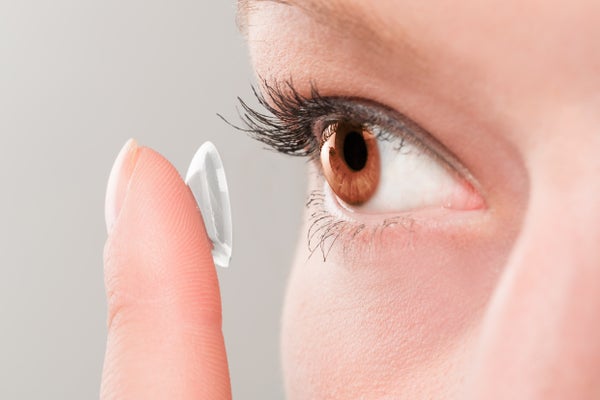Every year, Americans flush 2.6 to 2.9 billion contact lenses down the drain, according to new research from Arizona State University. By tallying this detritus and studying how it persists in this environment, the study provides the first estimate of the potential burden of these tiny plastics, or microplastics.
“There’s been a lot of research done on single-use, lower-value plastics such as straws, silverware and plastic bags,” says Charles Rolsky, an ASU doctoral student and the study’s lead author. Yet no one has yet looked at how these everyday medical devices may contribute to pollution in our soil and waterways, he says.
To understand how lenses break down in sewage, Rolsky and his colleagues placed the corrective lenses in wastewater treatment tanks filled with hungry microorganisms. The team left the lenses in this brew for 14, 96 or 172 hours—the typical range of time waste may spend in such facilities—but they discovered the lenses had only begun to degrade slightly after 172 hours in this environment.
On supporting science journalism
If you're enjoying this article, consider supporting our award-winning journalism by subscribing. By purchasing a subscription you are helping to ensure the future of impactful stories about the discoveries and ideas shaping our world today.
That failure to break down led the researchers to a startling conclusion: as much as 23,000 kilograms of lenses (about 50,000 pounds) may accumulate in sewage sludge in the U.S. each year. And because wastewater industry reports suggest about 55 percent of that waste is dumped into soils, the researchers estimate that 11,000 to 12,650 kilograms (about 24,000 to 28,000 pounds) of contaminant-harboring contact lens fragments end up in U.S. dirt annually. A still unknown amount may flow into oceans and rivers.
The calculation of how many lenses end up in our wastewater plants and habitat hinged on a variety of data sources. The U.S. Centers for Disease Control and Prevention states that about 45 million Americans wear contact lenses. By using data from the major contact lens manufacturers about the various types of contacts purchased (daily, biweekly or monthly), the ASU researchers were able to calculate that Americans wear a total of 13.2 to 14.7 billion lenses a year. Next the researchers surveyed more than 400 contact lens users about how they dispose of the products, finding that 21 percent discard their lenses down the toilet or sink. Those cumulative numbers helped them arrive at their estimate of more than 2.5 billion lenses residing within our sewage in a given year. The research was presented on Sunday at the American Chemical Society’s annual meeting in Boston.
Big data on wastewater is largely unavailable, and quantifying the mass of microplastics is challenging, says Sherri Mason, a professor of chemistry at the State University of New York at Fredonia. “[The study researchers’] method of making assumptions and estimations is quite reasonable,” she adds.
Once sewage laden with contact lens fragments is pumped onto soil it may seep into the environment in different ways, the researchers say. Rain could wash lenses into rivers and oceans, where they would float like tiny, tentacle-less jellyfish. Or they could sit in soil, desiccating in the sun. The latter scenario is not harmless, says Rolf Halden, director of ASU’s Biodesign Center for Environmental Health Engineering and one of the study’s authors. “Once these lenses dry, they become incredibly brittle and will very likely shatter into very small particles.” When these microplastics persist in the environment they can be consumed by animals, birds or insects and make their way into the food chain.
“Contacts are designed to absorb liquid, and that includes not just water but anything that’s in the water,” Mason says. “So I would be concerned that there would be more of an impact with these microplastics than with the other materials because of their ability to absorb various toxins in the environment, like pesticides and herbicides, and really hyper-concentrate these chemicals and move them into the food chain and up the food chain.”
If filter feeders and small fish ingest the contacts, whether whole or shattered, it could cause a blockage in their bodily functions. In addition, “It’s been documented that organisms that ingest plastic have a lower propensity to feed because they already feel full. And because that’s not providing nutrients, it is possible for organisms like that to starve,” Rolsky says.
Although contact lens pollution is a concern, it is dwarfed by the eight million metric tons of larger plastic that clogs our oceans every year. But unlike the daunting task of slashing grocery bag and water bottle use, there’s an easy way to prevent contact lenses from becoming pollutants, the ASU researchers note. “Definitely throw them in the solid waste compartment of the house—the garbage can is preferable to the sink or the toilet,” Rolsky says. Alternatively, Bausch & Lomb offers a recycling program for any brand of contact lenses and packaging.
Earlier research on the individual waste from an average person’s disposable contact lenses in the United Kingdom looked more broadly at the environmental footprint of contacts and compared it to waste from soda cans, suggesting that the lens-related waste is relatively small, per person—roughly equivalent to the disposal of 15 cans of Coca Cola per year.
Contact lens companies often provide no package instructions about where to dispose of lenses, the ASU researchers note. But they hope to change that. “We’d love to have a dialogue [with manufacturers] and establish a solid protocol for consumers to dispose of or even recycle their contact lenses,” Rolsky says. “That might have a drastic effect all by itself.”
